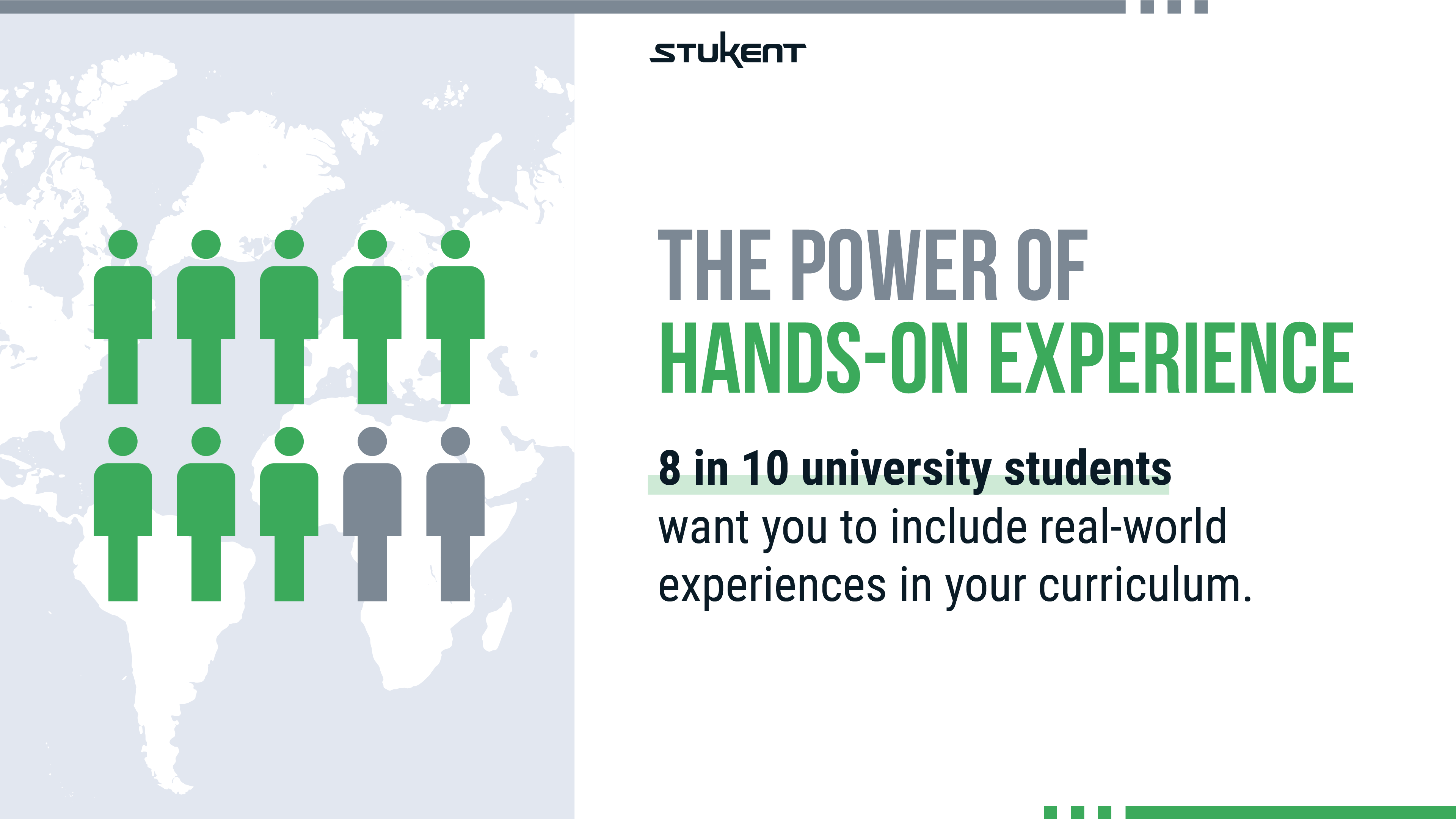8 in 10 University Students Want You to Include Real-world Experiences in Your Curriculum
Thanks to the challenges wrought by the Covid-19 pandemic, student engagement in the classroom is at an all-time low. A recent report shows undergraduate and graduate students alike are struggling to stay interested in class. So, what are instructors and administrators to do? How can institutions of higher education curb this issue and help their students find increased value in classroom instruction?
According to the report, “The State of the Student 2022” by academic publisher Wiley, more than 80% of students want their education to include real-world work experiences. The survey shared several notable findings, further underscoring how important it is to include hands-on, relevant experiences for students.
Want to know more about the survey and learn how you can bring authentic, hands-on experiences into your classroom? Read on!
By the Numbers
The survey was conducted in August 2022. 5,258 students and 2,452 instructors in North America were asked to name the factors that have the greatest impact on student success.
The results? Students at both the graduate and undergraduate levels overwhelmingly agreed that hands-on work helped them to stay engaged and to retain what they were learning.
More than 80% of students agreed that their educational institutions needed to incorporate projects that mimic real-world work. Another 53% of undergraduate students and 38% of graduate students said they struggled to remain interested in course materials; and 55% of undergraduate students and 34% of graduate students said they have trouble maintaining the material they learned.
The results also showed students are more likely to stay interested in a subject if they can see how it relates to their desired future careers. Hands-on experience does exactly that — it helps students connect the material they’re learning to the real world. Not only can students see real-world concepts in action, but they gain insights into the material that will help them make important connections later, too.
The Associate Director for Indiana University’s Center for Postsecondary Research and the National Survey of Student Engagement, Jillian Kinzie, explained that “students have always been interested in incorporating more real-world experience into their learning. … They’ve also provided a solution — simulation learning.”
Stukent’s CEO and founder, Stuart Draper, agrees. “Hands-on experience makes a skill intuitive,” he says. “There’s a reason people say, ‘It’s just like riding a bike’ — once you’ve learned how to ride, it isn’t something you’ll easily forget. That’s why simulations are so important to business education.”
The Power of Simulations
Simulations have been proven to increase student engagement and the retention of skills learned in the classroom. Another recent study shows simulations are key to increasing student engagement and connecting learning to real-life scenarios.
In a survey of more than 4,000 students, Stukent found that simulated learning provided students with a better overall learning experience.
Here are seven key points from the survey that show how simulations improve student learning:
- Students prefer courses that use simulations. Simulations bring courses to life and allow students to take on professional roles.
- Simulations prepare students for real-world opportunities. Over 64% of survey respondents who used simulations indicated that they agreed or strongly agreed with the statement: “Simulations were effective in preparing you for opportunities outside of the classroom.”
- Simulations improve students’ knowledge and confidence. Approximately 90% of respondents who used simulations reported that the simulations improved their confidence level and knowledge of the subjects for which they used the simulations.
- Students score highly in classes that use simulations.
- Simulations make other homework more valuable. Simulations equip students with professional context and experience that makes other assignments clearer and more meaningful.
- Classes that use simulations are more fun. Over 70% of survey respondents who used simulations agreed or strongly agreed classes that use simulations are more fun than those that don’t.
- Simulations get instructors involved as mentors.
So, what’s the solution for increasing student engagement in the classroom? It could be as simple as incorporating one of Stukent’s 40+ turnkey Simternships™ in your classroom.
The Simternship™ Solution
At Stukent, we offer an experience to students that goes beyond the typical business simulation: A Simternship. A Stukent Simternship places students in a realistic working environment, allowing them to gain experience, build marketable skills, increase their knowledge retention, and yes, even make a few mistakes in a low-risk setting.
In a Simternship, your students gain valuable insights into the day-to-day decisions, tools, and expectations of a position or role. Simternships mimic real-world workspaces, which means students will need to communicate with superiors, coworkers, and customers while managing their assigned tasks. Best of all, Stukent Simternships are auto-graded and integrate into your preferred LMS, which means they won’t make more work for you.
Simternships are an easy way to engage your students in your course material like never before. Talk to a Stukent course consultant today to see how a Simternship can transform your curriculum!
At Stukent, we’re here to help educators help students help the world. To learn more about our revolutionary courseware and Simternships, or to get FREE instructor access to our products, visit our website.






